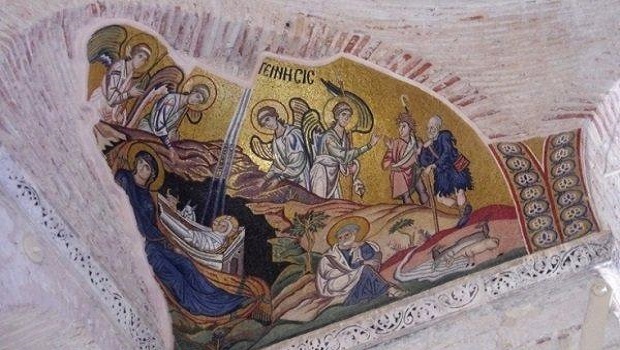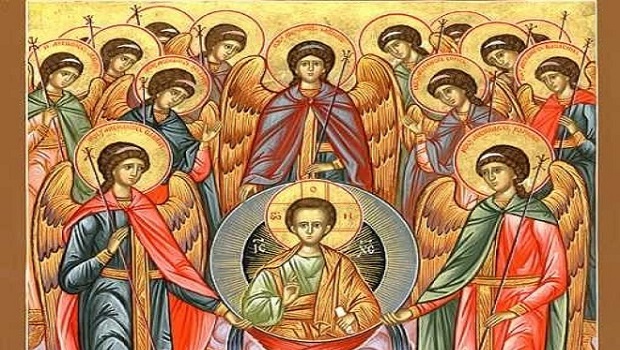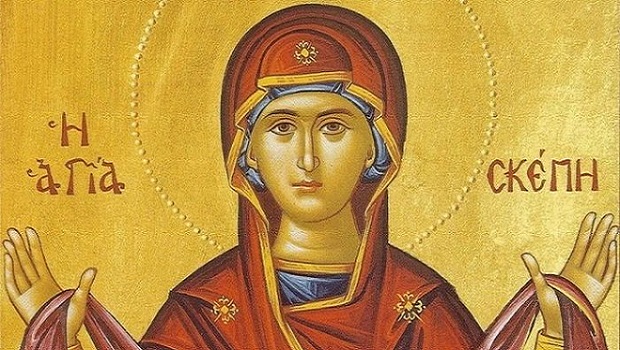One of the more curious features of living in Greece is that, if you go to a football match on the Sunday of the Publican and the Pharisee, one of the messages relayed to the crowd at half-time is always: “The Triodion is open! Bring your family and friends to Such-and- Such Taverna”. There follows a long (long!) list of all the amazing meat dishes they will prepare for your delectation, mostly over a charcoal grill. I confess that there have been occasions, when, after an insipid first half, I have cut my losses and repaired to the said taverna and supported these stalwart culinarians in their noble efforts.
This is not, of course, what we usually associate the Triodion with, but it is in keeping with the preparation for Lent. The week after the Publican and the Pharisee is fast-free and the next week allows for meat, except on Mondays and Fridays. Thereafter comes the week when dairy products are allowed.
We also have texts which state that the rules for monastics and the rest of us are the same. Patriarch Nikolaos, at the beginning of the twelfth century, wrote a poem in which he says:
“For the holy apostles impose terrible and great
Terrible and great exactitude for these days
We should eat only bread, salt and vegetables,
and similarly have only water to drink”.
And he adds:
“And this meticulousness in fasting, of which I write,
was not written for us monastics only,
but for all the faithful…”.
But about a hundred years later, Metropolitan Dimitrios Khomatianos replied to Konstantinos Kavasilas, who had asked him for information regarding fasting:
“On fast days, at the ninth hour, we render the usual prayers and hymns to God, and break our fast, eating only bread and fungi and dates and vegetables, and instead of drink, water for the comfort of the body”.
This perhaps brings to our attention the difference between fasting and abstinence, although the distinction is not as clear in the Orthodox Church as it is in the Church of Rome. Most non-monastics would have found it impossible to continue with their daily lives for any length of time by breaking their fast at the ninth hour, after having rendered prayers and hymns to God. They would, however have been able to observe a simple diet.
Just how simple the diet would have been is a matter of speculation. At the time of Justinian (5th-6th c.), there were 400-500,000 people living in Constantinople. What on earth did they all eat? Probably not much by way of meat, because the strain on resources would have been enormous. By the same token, dairy products would have been in relatively short supply. Fish, on the other hand, was plentiful, as it was in other large cities (Thessaloniki, Patra, Corinth, Athens/Piraeus, Alexandria, Nicea, Trebizond and so on). Other than that, they would have eaten a great deal of pulses and vegetables and, of course, bread. By and large, people in cities in the New Roman empire ate bread, made mostly with the ancient grain emmer wheat (farro), rather than the various forms of polenta which were more common in Old Rome. Interestingly, this grain is now staging something of a comeback because it contains significantly smaller amounts of gluten.
What of the vegetables? We do have an Ancient Greek work, Geoponika, which has survived due to the efforts of Emperor Konstantinos Porfyroyennitos (Porphyrogennitus) in the 10th century, though the sources were collected four centuries earlier by one Kassianos Vassos. It is a veritable mine of information concerning ancient horticultural lore, some of it going back as far as ancient Persia, and, in chapter 12, treats of vegetables, as these should be grown in their proper seasons in Constantinople.
It is, of course, difficult to say how closely these vegetables are related to their modern counterparts. Carrots, for example, were all sorts of colours originally and became the familiar orange due to the efforts of Dutch growers. Usage has also changed: turnips were eaten in Byzantium largely for their leaves, or roots, whereas today, in Greece, they are mostly used as animal fodder. The information in the Geoponika can be confirmed to some extent from a letter written in Latin (De Observatione Ciborum) by the Byzantine doctor, Anthimos, to Theuderic, son of Clovis, the founder of the Merovingian dynasty.
So, as well as bread, the Byzantine population of large towns and cities would have eaten fish, dill, carrots, mint, radishes and chicory, rocket, savory, cardamom, coriander, onions, lettuce of various kinds and other greens. Obviously there was no sign of those staples of modern Greek cooking, potatoes, tomatoes and peppers.
This sounds a rather spare diet, and no doubt in times of hardship it was, but we should remember that the Greeks are very talented and ingenious chefs. Much of what we associate with the Mediterranean diet originated in Greece (including Crete and Cyprus), though other countries have added their local recipes and style. Thus, there would have been taramosalata, octopus, fried squid, fyllo pastry and, therefore, pies and sweets with nuts and honey. Even the poorest houses would have made babanatsa, a very simple kind of pie stuffed with some sort of green vegetable, such as spinach, leeks or- even better- nettles, which is still cooked today.
And there were plenty of herbs, such as sage, marjoram, oregano, thyme and lemon balm, which were freely available. Sauces would have been made in the traditional way, by pounding bread with a cooking liquid. One such, skordalia, which is made with garlic, is still popular today, and is traditionally eaten with salt cod on March 25, when fish is allowed for the Annunciation. After the first contacts with the Arabs, aubergines (egg-plants) would also have become available. And of course, many of these would have been preserved for consumption in the winter months as pickles, another feature of Byzantine cuisine which remains popular.
Some people, of course, are never satisfied. Mihaïl Khoniatis, Archbishop of Athens, who was exiled to the island of Kea for harbouring a prelate of the Church of Rome, wrote a letter saying: “Although we are sojourning in the heart of the sea, we do not have fish”. Since he had already been living in exile there for 11 years, one can only conclude that it was his own fault if he was missing out. But that’s Khoniatis for you. This is his letter 103 and almost all of them are complaints.
There is, however, another very interesting source which supplements our knowledge: a wonderful lecture by the great Professor Nikolaos Andriotis, entitled The Pre-Greeks, a tour de force of which Tolkein himself would have been proud. Andriotis tells us that, when the Greeks moved down from the north into what is now their homeland, they borrowed words from surrounding peoples to describe concepts or material things with which they were not familiar (Olympus, Athena, Apollo, even thalassa, “sea”). Among the plants they met were absinthe, courgettes (zucchini), almond, vetch, asphodel, bay, capers, cherry, cumin, rice, celery, sesame, cucumbers, mustard and figs.
The ordinary diet for these city-dwellers, then, would not have differed very much from that of monks and nuns. In the countryside, it would have been different. Dairy products would have been more readily available, for a start. And then there was game. There is a text by Xenophon, On Hunting, which makes it clear that Greeks were very skilled at this from centuries before Byzantium (It is available as a free e-book, in English, though you might want to skip chapter I, which is simply a Hall of Fame of famous hunters. Chapter two, however, will tell you all you’ve ever wanted to know about the qualities desired in a net-keeper). And, since pastoral lands were often inland or even on mountains, meat from domesticated animals would have replaced the fish in the diet of those who lived near the sea.
So the rules for fasting may have been the same for all, but there is an “unfairness” about them, as can be seen from the above. A dispensation for fish, for example, is all very well if you lived anywhere near the sea-except Kea, obviously- but not much use if you were up a mountain. By the same token, a nomadic shepherd community would not have had the same access to olive oil (though they may have bartered for it, of course) and would therefore have depended more heavily on butter and cheese, so, again, a dispensation for oil would still have left them with dry bread.
As Christianity spread, geographical factors would also play a part. In his letter to Theuderic, quoted above, Anthimos refers to certain specifically Frankish foods, such as lard, smoked and potted meat, beer and mead. One would have to say that mead, for example, falls within the category of “wine”, i.e. an alcoholic drink, according to the spirit rather than the letter of the rules. Yet there are many monks on the Holy Mountain who do not include the local distilled spirit as wine, not from any self-indulgent casuistry but because they often drink it as an accompaniment to coffee rather than as part of a meal and so will drink a glass even on fast days. So it seems a little harsh to deny any form of dispensation to a poor farmer in the country outside Nizhny Novgorod, given that his chances of indulging in wine and olive oil would have been minimal.
Considerations such as this affected the way fasting developed in the East and West. And nowadays we have other considerations, such as an enforced life-style within a secular or at least non-Orthodox society. And here in Greece, at least, fresh fish is no longer a common food for the vast majority of people, but an expensive luxury which fewer and fewer people can afford. Is it therefore within the spirit of the rules of fasting to spend a considerable amount of money on a luxury item rather than purchasing, say, a piece of cheese? It may be that this was the reason behind the inclusion of “white meat”, i.e. cheese, among the foods allowed for fast days in Northern Europe, starting in the 9th century.
All of the above, however, is really concerned with abstinence, which is itself a good thing, since it is an expression of cutting off one’s own will. This is not fasting, however. Fasting is not about which foods you can eat, but about not eating. The inspiration for this form of spiritual exercise came, not from the cities, but from the desert, and the Church has always considered it very beneficial. Not only the Orthodox, but also Rome. Pope Benedict XIV, for example, wrote in 1741: “The observance of Lent is the very badge of the Christian warfare. By it we prove ourselves not to be enemies of the Cross of Christ. By it we avert the scourges of divine justice. By it we gain strength against the princes of darkness; for it shields us with heavenly help. Should mankind grow remiss in their observance of Lent, it would be detrimental to God’s Glory, a disgrace to the Catholic religion, and a danger to Christian souls. Neither can it be doubted that such negligence would become the source of misery to the world, of public calamity and of private woe”.
His successor, Clement XIII, confirmed this in Appetente Sacro, in 1759.
In his chapter on The Meaning of the Great Fast, in his translation of the Lenten Triodion, Metropolitan Kallistos (Ware) has this to say:
“The primary aim of fasting is to make us conscious of our dependence upon God. If practised seriously, the Lenten abstinence from food- particularly in the opening days- involves a considerable measure of real hunger, and also a feeling of tiredness and exhaustion. The purpose of this is to lead us in turn to a sense of inward brokenness and contrition… If it is important not to overlook the physical requirements of fasting, it is even more important not to overlook its inward significance. Fasting is not a mere matter of diet. It is moral as well as spiritual. It is to return to God, to come home, like the Prodigal, to our Father’s house”.
We are reminded of the true nature of the Fast at Vespers on the Sunday of Forgiveness. Immediately after the priest has changed into his dark, Lenten vestments, we have the apostikho: “Your grace has shone forth, Lord, the illumination of our souls has shone. Behold the acceptable time; behold the season of repentance. Let us cast aside the works of darkness and gird ourselves in the armour of light, that, having sailed across the great sea of the Fast, we may come to the three-day Resurrection of our Lord Jesus Christ, the Saviour of our souls”.
May God grant us all such a Fast.
Source: pemptousia.com
ABOUT THE ORTHODOX CHRISTIAN NETWORK
Orthodox Christian Network (OCN) is a 501(c)3 and an official agency of the Assembly of Canonical Bishops of the United States of America . It is a recognized leader in the Orthodox Media field and has sustained consistent growth over twenty-two years. We have worked to create a community for both believers and non believers alike by sharing the timeless faith of Orthodoxy with the contemporary world through modern media. We are on a mission to inspire Orthodox Christians Worldwide. Click to signup to receive weekly newsletter.
Join us in our Media Ministry Missions! Help us bring the Orthodox Faith to the fingertips of Orthodox Christians worldwide! Your gift today will helps us produce and provide unlimited access to Orthodox faith-inspiring programming, services and community. Don’t wait. Share the Love of Orthodoxy Today!
OCN has partnered with Pemptousia. A Contemporary post-modern man does not understand what man is. Through its presence in the internet world, Pemptousia, with its spirit of respect for beauty that characterizes it, wishes to contribute to the presentation of a better meaning of life for man, to the search for the ontological dimension of man, and to the awareness of the unfathomable mystery of man who is always in Christ in the process of becoming, of man who is in the image of divine beauty. And the beauty of man springs from the beauty of the Triune God. In the end, “beauty will save the world”.




0 Comments